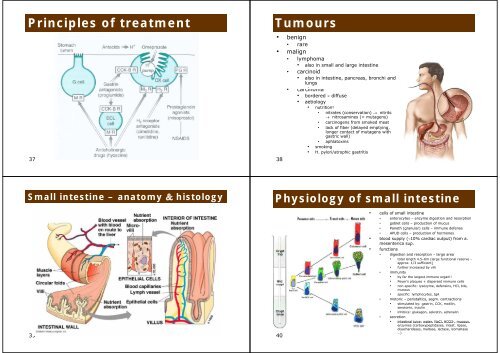Pathophysiology of GIT I
Pathophysiology of GIT I Pathophysiology of GIT I
Principles of treatment 37 Small intestine – anatomy & histology 39 Tumours • benign • rare • malign li • lymphoma • also in small and large intestine • carcinoid • also in intestine, pancreas, bronchi and lungs • carcinoma • bordered × diffuse • aetiology 38 • nutrition! • nitrates (conservation) → nitrits → nitrosamines (= mutagens) • carcinogens from smoked meat • lack of fiber (delayed emptying emptying, longer contact of mutagens with gastric wall) • aphlatoxins • smoking • H. pylori/atrophic gastritis Physiology of small intestine 40 • cells of small intestine • enterocytes – enzyme digestion and resorption • goblet cells – production of mucus • Paneth (granular) cells – immune defense • APUD cells – production of hormones • blood supply (∼10% cardiac output) from a. mesenterica sup. p • functions • digestion and resorption – large area • total length 4.5–6m (large functional reserve - approx. pp 1/3 sufficient) ) • further increased by villi • immunity • by far the largest immune organ!! • Peyer’s plaques + dispersed immune cells • non-specific: lysozyme, defensins, HCl, bile, mucous • specific: lymphocytes, IgA • motoric – peristaltics, segm. contractions • stimulated by: gastrin gastrin, CCK, CCK motilin, motilin serotonin, inzulin • inhibice: glukagon, sekretin, adrenalin • secretion • intestinal juice: water, NaCl, HCO3-, HCO3 , mucous, enzymes (carboxypeptidases, intest. lipase, disacharidases, maltase, lactase, izomaltase …)
Intestinal secretion and absorption 41 • enterocytes in in jejunum and ileum produce alkalic fluid • water • electrolytes • mucous • control of secretion • hormones • drugs • toxins (e.g. cholera, dysentery, E. coli) • types of intest. absorption • passive diffusion (conc. gradient) • aqueous pores (e.g. urea, some monosaccharides) • transmembrane (e.g. ethanol, FFA) • via tight junctions (e.g. ions, water) • carriers • ions, Glc, AA • active transport on the basolateral membrane • Na/K ATPase produces conc. gradients g for secondary y active transports Disorders of intestinal secretion and d absorption b ti = diarrhea di h • diarrhea = more frequent expulsion of stools (>3×/day), often more liquid consistence co s s e ce → loss oss of o fluid u d • due to imbalance between 3 main factors – secretion, resorption and motility • acute • infection • dietary error • alimentary li t iintoxication t i ti • chronic • malabsorption (inflammatory bowel disease (Crohn disease, ulcerative colitis), chron. pancreatitis, liver and biliary diseases) • colorectal carcinoma • neurogenic • metabolic (uremia, hyperthyreosis, adrenal insufficiency) • etiology • infection, toxins, diet, neuropsychological (anxiety) • pathogeneses • ↑ osmotic pressure (and thus water) in intest. lumen = osmotic • typically when large amount of undigested nutrients stays in lumen • malabsorption syndrome (pancreatic insufficiency, biliary, disacharidaae deficiency – e.g. lactase) • ingestion (overdose) of salts (Mg, sulfates), antacids • bacterial overgrowth, g , resection, , obstruction of lymphatics y p • ↑ secretion of Cl (and thus water) into lumen = secretory • bacterial enterotoxins (Vibrio cholerae, Shigella dysenteriae, E. coli, Clostridium difficile, Salmonella typhi) • inflammatory exudation (Crohn d., ulcerative colitis) • hypemotility • some regulatory g y peptides p p (VIP, ( , serotonin, , PGE) ) 43 Intestinal immunity 42 Types of diarrhea 44
- Page 1 and 2: 1 Pathophysiology of GIT I Oral cav
- Page 3 and 4: Disorders of oesoph. motility • a
- Page 5 and 6: Pathophysiology of stomach 17 Gastr
- Page 7 and 8: Interplay of paracrine GIT factors
- Page 9: 33 Symptoms of gastric vs. duodenal
- Page 13 and 14: Obstructive and paralytic ileus 49
- Page 15 and 16: Lactose intolerance prevalence 57 C
- Page 17: Tumors of large intestine • benig
Principles <strong>of</strong> treatment<br />
37<br />
Small intestine – anatomy & histology<br />
39<br />
Tumours<br />
• benign<br />
• rare<br />
• malign li<br />
• lymphoma<br />
• also in small and large intestine<br />
• carcinoid<br />
• also in intestine, pancreas, bronchi and<br />
lungs<br />
• carcinoma<br />
• bordered × diffuse<br />
• aetiology<br />
38<br />
• nutrition!<br />
• nitrates (conservation) → nitrits<br />
→ nitrosamines (= mutagens)<br />
• carcinogens from smoked meat<br />
• lack <strong>of</strong> fiber (delayed emptying emptying,<br />
longer contact <strong>of</strong> mutagens with<br />
gastric wall)<br />
• aphlatoxins<br />
• smoking<br />
• H. pylori/atrophic gastritis<br />
Physiology <strong>of</strong> small intestine<br />
40<br />
• cells <strong>of</strong> small intestine<br />
• enterocytes – enzyme digestion and resorption<br />
• goblet cells – production <strong>of</strong> mucus<br />
• Paneth (granular) cells – immune defense<br />
• APUD cells – production <strong>of</strong> hormones<br />
• blood supply (∼10% cardiac output) from a.<br />
mesenterica sup. p<br />
• functions<br />
• digestion and resorption – large area<br />
• total length 4.5–6m (large functional reserve -<br />
approx. pp 1/3 sufficient) )<br />
• further increased by villi<br />
• immunity<br />
• by far the largest immune organ!!<br />
• Peyer’s plaques + dispersed immune cells<br />
• non-specific: lysozyme, defensins, HCl, bile,<br />
mucous<br />
• specific: lymphocytes, IgA<br />
• motoric – peristaltics, segm. contractions<br />
• stimulated by: gastrin gastrin, CCK, CCK motilin, motilin<br />
serotonin, inzulin<br />
• inhibice: glukagon, sekretin, adrenalin<br />
• secretion<br />
• intestinal juice: water, NaCl, HCO3-, HCO3 , mucous,<br />
enzymes (carboxypeptidases, intest. lipase,<br />
disacharidases, maltase, lactase, izomaltase<br />
…)



